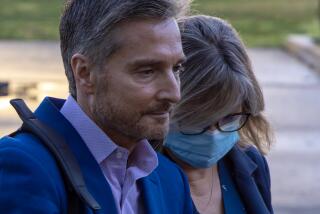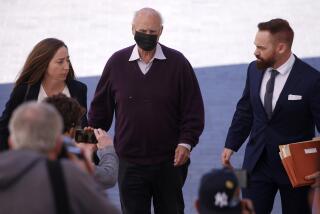Cause of Paralysis Is Questioned : Jurisprudence: Medical records indicate that Bill Shoemaker had movement at hospital for several hours after his accident.
- Share via
Jockey Bill Shoemaker, now a quadriplegic, was not completely paralyzed immediately after his car accident and for several hours thereafter while being treated at Glendora Community Hospital, according to medical records and legal documents obtained Friday by The Times.
The documents show that Shoemaker had movement in his head, neck and shoulders after arriving at the hospital following a serious auto accident in April of 1991. Shoemaker’s movement was so pronounced that, at one point during treatment, he moved his shoulders enough to pull an intravenous needle from his arm.
This surprising information came to light in documentation of an agreement between attorneys for Shoemaker and the Ford Motor Co., which guarantees the former jockey and his family at least $1 million and up to $2.5 million from the auto manufacturer.
A lawsuit was filed April 6, 1992, on behalf of Shoemaker and his wife against the Glendora hospital and several doctors. The suit alleged that the treatment he received “exacerbated the spinal injuries Shoemaker may have received in the accident, resulting in Shoemaker’s quadriplegia.” Details of the alleged mistreatment were kept secret until Ford filed a motion for settlement on Friday.
Shoemaker, the winningest jockey in the history of horse racing, was driving a Ford Bronco II on April 8, 1991, when his vehicle veered off Highway 30 in San Dimas, hit a berm on the side of the road and rolled 50 feet down the side of an embankment. At the time of the accident, tests showed that Shoemaker’s blood-alcohol level was 0.13, above the legal limit of 0.8. However, he was not charged with driving under the influence, because of the severity of the injuries and the fact that nobody else was involved in the crash.
Immediately after the accident, Shoemaker was transported to Glendora Community Hospital, where he was treated and, almost eight hours later, diagnosed as being a quadriplegic. Shoemaker has shown slight improvement since then, having regained some head movement. He has resumed his career as a thoroughbred trainer in Southern California.
Shoemaker told a family friend this week that he should not have been paralyzed and that doctors, after viewing X-rays, initially started treating him for a broken pelvis, an injury he suffered several years earlier from a horse racing accident at Hollywood Park.
According to the hospital report filed by Dr. Leslie Wise, Shoemaker arrived at the hospital emergency room at 8:35 p.m. and X-rays were ordered from the skull to the sixth cervical vertebra (the top half of the back).
Wise’s report also says that, at 9:08 p.m.: “I was in the vein one time, but the patient rolled his shoulders and pulled the needle out and I was unable to reinsert it.”
Dr. Alfonso Miguel, in a consultation report, said that at 9:47 p.m., “He (Shoemaker) was moving his neck and head and talked coherently until he was orally intubated.”
Orally intubating, or placing a tube in the throat to assist in breathing, usually requires the manipulation of one’s neck.
According to documents, Dr. Celedonio Fernando, a neurosurgeon, was consulted at 12:30 a.m., and after looking at the X-rays said they were “not adequate” and asked for new X-rays taken below the sixth cervical vertebra. At 4:10 a.m., almost eight hours after entering the hospital, the new X-rays were taken and Fernando concluded in his notes that Shoemaker was “a quadriplegic now.”
The X-rays showed a dislocation of Shoemaker’s spine between the sixth and seventh vertebrae.
Dr. Paul Waters, one of those named in the suit from Glendora Hospital, has recently had a motion for summary judgment filed on his behalf--an action that would dismiss him from culpability. His attorney, H. Gilbert Jones, responded to Friday’s filing saying: “While I feel sympathy for Mr. Shoemaker, in my opinion he doesn’t either legally or morally have any real case against the doctors who, in my view, saved his life. He did have an extremely high blood-alcohol (level), which was not the fault of any of the doctors. I find going after the doctors inappropriate.”
Neil Papiano, the attorney who represents Shoemaker, said: “Shoemaker’s blood-alcohol level has nothing to do with how he was treated at the hospital. I don’t think Bill was drunk at the time and if you note, he was given a significant amount of liquids at the hospital and we have no idea what was in those liquids.”
The suits will most likely revolve around what occurred at the hospital and when he was properly diagnosed.
Marje Everett, who ran Hollywood Park for many years, was at the hospital that night.
“There was a small group of friends that were there,” Everett said. “I was there from 11 p.m. until 4 a.m., and some people stayed longer than me, and none of us heard anything about paralysis.”
Eddie Delahoussaye, a jockey and longtime friend of Shoemaker’s was also at the hospital.
“I was there all night that first night, but nobody was saying anything about Bill being paralyzed,” he said. “Offhand, I don’t remember when I first heard it. . . . I for sure know it wasn’t that night, probably not even the next morning.”
The incidents surrounding Shoemaker have led to the second major medical malpractice charge involving a Southland athlete since 1990. The death of Hank Gathers, a Loyola Marymount basketball who player collapsed on the court and died about 90 minutes later, led to a series of highly publicized suits concerning his care. Most of the claims were settled out of court.
The major suit filed by Shoemaker is against Glendora Community Hospital, Crippen Ambulance Service and Glendora personnel Wise, Miguel, Waters, Fernando, Demetrio Hechanova, Billy Leon, Donald Shapiro and Cerna Atil.
A second suit, for $25 million, is against the State of California for allowing a “dangerous condition” to exist on the highway, without benefit of a guard rail.
This suit is viewed as a backup should the court rule that, if a guardrail were installed, then the hospital would not have treated Shoemaker and any alleged negligence would not have occurred.
Shoemaker did not sue the Ford Motor Co., but instead negotiated a “good faith settlement” by which he is given $900,000, wife Cindy $75,000 and daughter Amanda $25,000. The settlement also guarantees that, if Shoemaker does not receive at least an additional $1.5 million from the other defendants, the auto maker will make up the difference.
“We’ve reached what we believe is a good resolution with Ford and the matter will now continue against the other persons whom Ford has stated have the primary responsibility in this matter,” Papiano said.
In return for the agreement, Shoemaker will not pursue any claims against Ford. The agreement stipulates that, if Shoemaker settles prior to trial with the State of California, Ford will owe Shoemaker no additional money. If Shoemaker settles with any other defendants, Ford must approve the action.
“Ford is guaranteeing a certain amount of money if they take us to trial,” said Chris Hiddleson, an attorney who represents the State of California. “So what you have is a major automobile company guaranteeing him a lot of money to go after the taxpayers. . . . Our reactions were outrage that an auto manufacturer would pay somebody that is drunk to come after us.”
Times Sports Editor Bill Dwyre contributed to this story.
More to Read
Go beyond the scoreboard
Get the latest on L.A.'s teams in the daily Sports Report newsletter.
You may occasionally receive promotional content from the Los Angeles Times.











